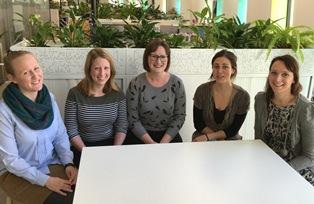Months of planning may be behind them but there is still plenty of hard work ahead for five UTS scientists leaving from Fiji this week for a voyage that ends in Hobart two weeks later. The researchers, all from the UTS Climate Change Cluster (C3), will be spending countless hours collecting, processing and analysing seawater samples, albeit in the relative comfort of the new purpose built vessel, Marine National Facility (MNF) RV Investigator.

Whilst there are two main scientific streams to the voyage – marine geology/geophysics and bio-optics/biogeochemistry - the UTS contingent will be running “piggyback” experiments related to marine microbes as the ship cruises from Lautoka to Hobart.
There will be up to 25 measuring stations over the whole voyage: a package of instruments and sampling devices will be lowered on a CTD carousel or rosette to a depth of 500 metres at each station twice a day. Parameters measured include pigment, salinity, temperature, depth and concentration of particles in the water column. Additional sensors on the CTD frame include chlorophyll and CDOM fluorometers, absorption and backscattering meter, beam transmissometer and dissolved oxygen. The information helps scientists better understand current ocean health and, therefore, potential impacts of environmental change on marine primary productivity – something that affects everything from the air we breathe to the sustainability of fisheries and aquaculture industries.
For Associate Professor Martina Doblin, who leads the C3 Productive Coasts team it will also be an opportunity to use the MicroCSI, the self-contained mobile laboratory launched in 2015 she helped develop in collaboration with MNF and other universities. Together, with Dr Allison McInnes and C3 PhD candidate Charlotte Robinson, Doblin will be examining the temperature tolerance, diversity and activity of upper ocean microbial communities. This involves collecting surface seawater along the ship’s path, coordinated with morning CTDs, and conducting a series of microbial community characterisation assays using instrumentation contained within the UTS MicroCSI. This type of analysis is normally only available in a land-based laboratory, the “lab-in-a-box” technology means living cells can be investigated soon after sampling giving a better understanding of the role planktonic organisms play in our oceans.
Dr Bonnie Laverock from the C3 Ocean Microbes Healthy Oceans team is the Chief Investigator for projects investigating how microbes contribute to carbon, nitrogen and sulphur cycling in the Coral Sea and spatial scale patterns in photo-physiology and primary productivity. Together with colleague Dr Liz Deschaseaux they will be collecting samples to investigate DMS/P production by phytoplankton and bacteria. DMS/P are important sulphur compounds that contribute to cloud formation and play a role in predator-prey interactions but there is still much to learn about these "smell of the sea" gases. Dr Deschaseaux is also working on developing new improved methods for DMS preservation and analysis in seawater.
Like to know more:
Voyage Plan, Follow RV Investigator (Near real time)
MicroCSI
Ocean Microbes and Healthy Oceans
Productive Coasts

